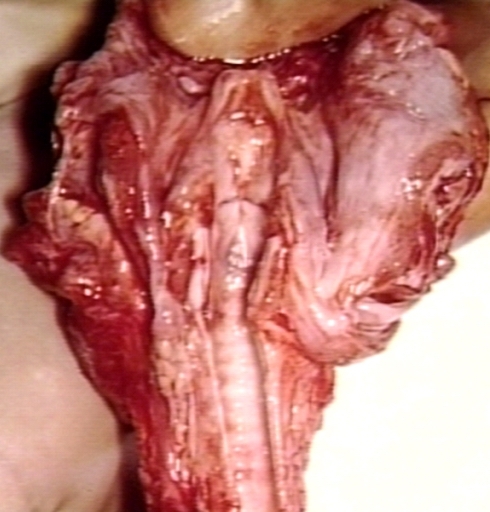Epiglottitis: Difference between revisions
| Line 29: | Line 29: | ||
==Treatment== | ==Treatment== | ||
Epiglottitis requires urgent endotracheal [[intubation]] to protect the airway. Ideally, this should be performed by an experienced [[anesthesiologist]] or [[respiratory therapist]], with [[otolaryngology]] back-up in case of failed intubation. If intubation fails, [[tracheotomy]] is required | Epiglottitis requires urgent endotracheal [[intubation]] to protect the airway. Ideally, this should be performed by an experienced [[anesthesiologist]] or [[respiratory therapist]], with [[otolaryngology]] back-up in case of failed intubation. If intubation fails, [[tracheotomy]] is required. | ||
==Complications== | ==Complications== | ||
Revision as of 13:33, 26 September 2012
| Epiglottitis | |
 | |
|---|---|
| Epiglottitis, Acute, Viral Etiology; Sudden Stridor and Obstruction in a Child. Image courtesy of Professor Peter Anderson DVM PhD and published with permission © PEIR, University of Alabama at Birmingham, Department of Pathology | |
| ICD-10 | J05.1 |
| ICD-9 | 464.3, 476.1 |
| DiseasesDB | 4360 |
| MedlinePlus | 000605 |
| MeSH | D004826 |
|
Epiglottitis Microchapters |
|
Diagnosis |
|---|
|
Treatment |
|
Case Studies |
|
Epiglottitis On the Web |
|
American Roentgen Ray Society Images of Epiglottitis |
For patient information click here
Editor-In-Chief: C. Michael Gibson, M.S., M.D. [1]
Overview
Cause
Symptoms
Diagnosis
Diagnosis is confirmed by direct inspection using laryngoscopy, although this may provoke airway spasm. The epiglottis and arytenoids are cherry-red and swollen. The most likely differential diagnostic candidates are croup, peritonsillar abscess, and retropharyngeal abscess.
On lateral C-spine X-ray, the thumbprint sign is a finding that suggests the diagnosis of epiglottitis.[1]
Treatment
Epiglottitis requires urgent endotracheal intubation to protect the airway. Ideally, this should be performed by an experienced anesthesiologist or respiratory therapist, with otolaryngology back-up in case of failed intubation. If intubation fails, tracheotomy is required.
Complications
References
- ↑ Jaffe JE. Acute Epiglottits. eMedicine.com. Available at: http://www.emedicine.com/Radio/topic263.htm. Accessed on: December 21 2006.
External links
- Jordana Marinoff, "Bacteria Grab a Windpipe and Hold it Hostage," Boston Globe, January 10 2006
Template:Respiratory pathology